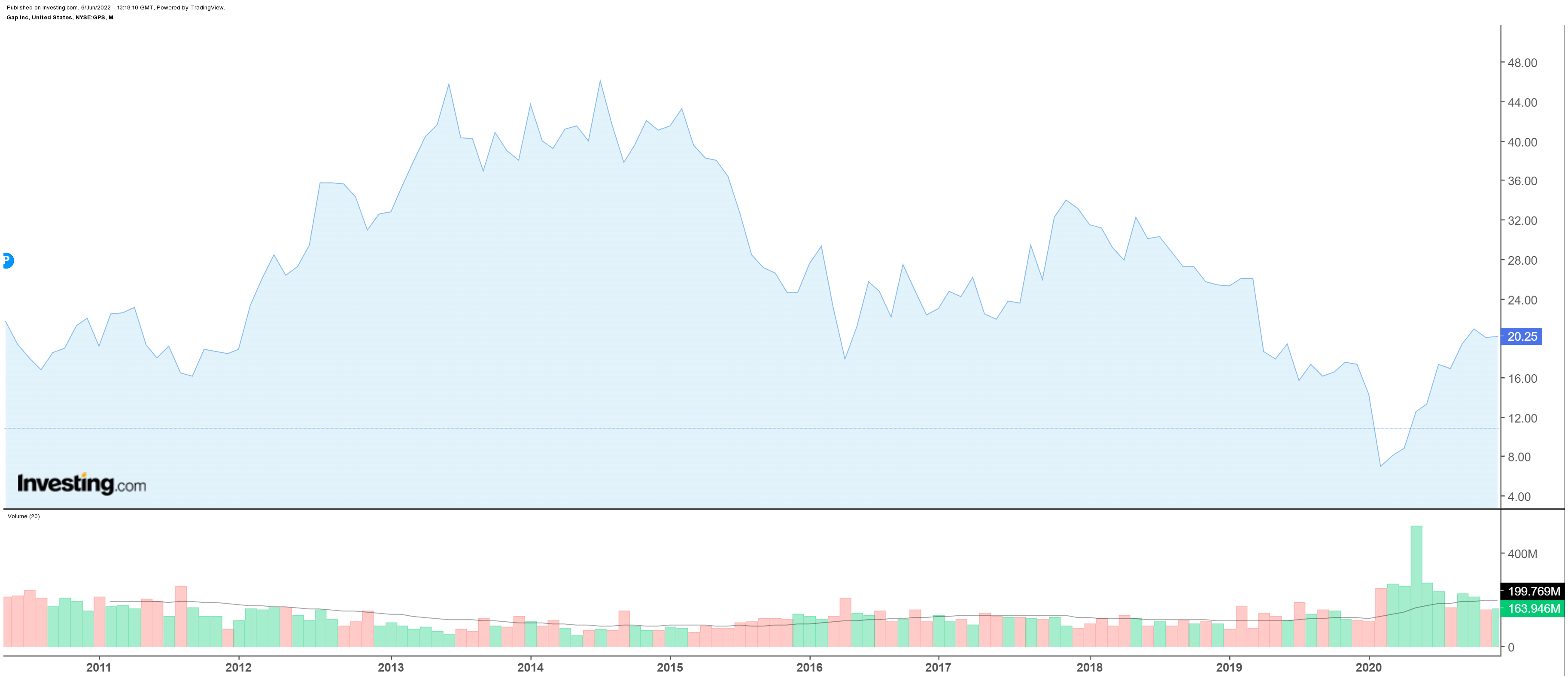It seems strange that a retailer like Gap Inc. (NYSE:GPS) could be a so-called “pandemic winner.” After all, Gap stores were closed for months during 2020 amid the COVID-19 pandemic. Even once stores reopened, expenses rose thanks to a tight labor environment and supply-chain challenges.
Meanwhile, spending on clothing, particularly for Banana Republic and the namesake Gap brand, would seem to take a hit during a time when customers were so rarely leaving their house.
But indeed, the pandemic proved to be a benefit for Gap and many other retailers. But the last few weeks show that a return to normalcy for the world means a return to normalcy for the sector.
The problem is that, before the pandemic, both Gap Inc. and the sector as a whole were struggling badly. In other words, history is repeating. And unless Gap finds a way to improve execution and combat long-running challenges, GPS stock isn't cheap, even 70% off last year's highs.
Gap Inc. Before The Pandemic
Between the beginning of 2010 and the beginning of 2020, Gap stock actually declined 16%. The S&P 500 nearly tripled over the same 10-year stretch.
To be fair, investors in GPS would have eked out a roughly 1% annualized return, including dividends. And there were some opportunities to make money:

Source: Investing.com
Gap rallied in the middle of a decade as a turnaround seemed to take hold. Shares would revert in 2015 and 2016, before rallying again beginning in late 2017.
What mostly drove Gap stock up — and down — over the period was Old Navy. Gap brand and Banana Republic generally struggled for most of the decade. Neither brand seemed particularly well-positioned from a fashion standpoint, as the “preppy” look has been mostly out of style for years now. That aside, mall retailers of all sorts failed to post much revenue growth last decade, and neither Gap brand nor Banana Republic was an exception.
Yet, at times, Old Navy seemed like it had found the antidote to growing e-commerce sales and the steady demise of the traditional mall. The brand's incredibly cheap prices provided some protection from e-commerce competition. Its minimal exposure to traditional malls insulated it from steadily declining visitation to those properties.
Athleisure brand Athleta has had some value, but for the most part, it's been Old Navy that has driven Gap stock. In fiscal 2012 (ending January 2013), same-store sales rose 6%, followed by 2% and 5% growth the next two years. Gap stock rallied as a result. In FY15 and FY16, Old Navy's growth stalled out; GPS stock fell. The brand soon bounced back, and so did GPS.
Indeed, even Gap management understood how critical Old Navy was. Gap Inc. enacted a multi-year plan to close as many Banana Republic and Gap stores as it reasonably could — but kept expanding Old Navy's footprint (and that of Athleta as well). In early 2019, Gap announced it was spinning off Old Navy — and Gap stock soared on the news.
But Old Navy's performance reversed once again. The company changed its mind about the spin-off, and by the beginning of 2020 GPS traded not far from an eight-year low.
The Problem With Gap Stock Now
Again, history shows how critical Old Navy is to Gap stock. And the problem right now is that Old Navy is posting its worst performance in many years, and potentially ever.
In the first quarter, Old Navy same-store sales were down a disastrous 22%. Execution was a big problem. The brand decided to significantly expand its plus-size assortment — but that simply meant it had too few items in every size.
That said, the assortment expansion — part of what the company calls its “Bodequality” initiative — doesn't seem like the only problem here. Retail sales are crashing everywhere, with the disastrous first quarter from Target (NYSE:TGT) last month the prime example.
There are short-term challenges for Old Navy and other retailers, most notably a gnarled supply chain. But Gap's own history belies the argument that the challenges are just short term. The mature mall brands Gap and Banana Republic (the latter of which admittedly had a strong first quarter) have been headed in the wrong direction for more than a decade now. Athleta can't compete with rival Lululemon Inc (NASDAQ:LULU), one of the best retailers in the world. In Q1, Athleta's same-store sales dropped 7%; Lululemon posted a 28% increase.
Those brands admittedly did well during the pandemic — but, again, mall retailers were surprising beneficiaries. Thanks to stimulus payments, consumers were flush. And supply-chain issues did provide one key boost: they limited inventory and, thus, limited promotional activity and pricing pressure across the space.
We're seeing in Q1 that promotional activity has returned. Abercrombie & Fitch Company (NYSE:ANF) posted a surprise loss in the quarter. Target got hammered. Gap disappointed.
In other words, retail in 2022 looks like retail in 2019. Of course, that's precisely the problem. By 2019, specialty retailers, Gap included, were in very real trouble.
Fixing Old Navy
And in 2022, Gap is in very real trouble. Its guidance for the year now contemplates adjusted operating margins of just 1.5% to 2.5% of sales.
That number alone shows how little room there is for error here. Bear in mind that after Q4 results — just three months ago — Gap guided for adjusted earnings per share of $1.85 to $2.05. The range now is $0.30 to $0.60.
At 2% operating margins, it only takes a little bit of erosion for earnings to fall 50% or more. Indeed, Gap's net interest expense is about 0.5% of this year's revenue.
Meanwhile, even after the high end of the outlook for FY22, GPS stock now trades for 17x earnings. Before the pandemic, it and other specialty retailers generally saw multiples that topped out at 12x.
So, even with GPS stock down 70% from last year's highs, the current price still incorporates some growth. And, again, that growth has to come from Old Navy. Old Navy has to get fixed.
To some degree, it likely will. Old Navy's chief executive officer left in April amid the plus-size fiasco. Fresh eyes from new management could drive needed changes. The disappointing performance this year at least will create easy year-prior comparisons next year. As pre-pandemic history shows, Old Navy has managed to create on-trend inventory and capture consumer attention, even if it's been inconsistent in doing so.
But Old Navy has to create that turnaround in a very different environment, one that includes higher labor costs, higher supply-chain costs and no real catalyst for higher demand. And so it's not guaranteed that Old Navy, as it has so many times before, will return to strength. Even if it does, the brand's profitability may not be what it once was.
To some extent, that might be priced in. Excluding the March 2020 dip as the market crashed, Gap stock is threatening a 25-year low. But for the decade before the pandemic, arguing that retail challenges were “priced in” was a good way to lose money. As we return to normalcy after the pandemic, that rule probably still applies.
As of this writing, Vince Martin has no positions in any securities mentioned.
